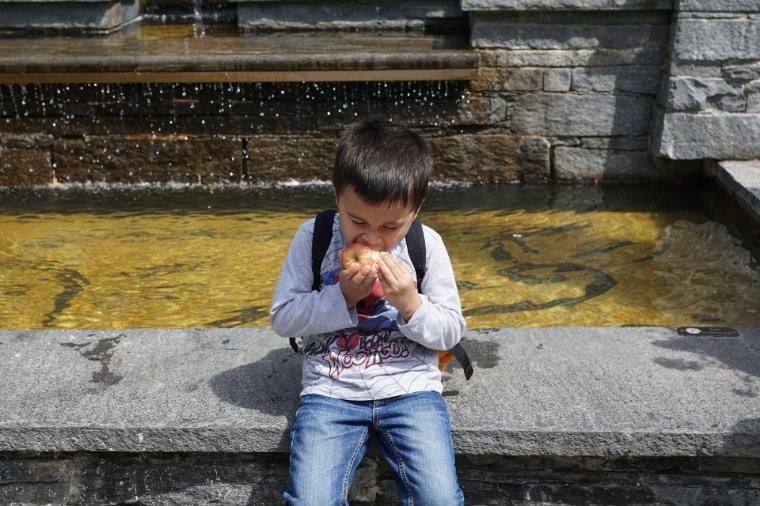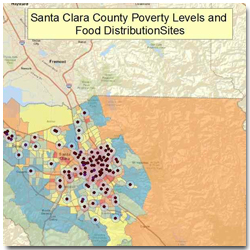Follow CFIE on Social Media
Food Insecurity
Hunger Index Research Update
Read the Full Hunger Index Report

Working together, for over a decade, the Center for Food Innovation and Entrepreneurship at Santa Clara University and Second Harvest of Silicon Valley have been measuring the need for food in Santa Clara and San Mateo Counties. The Hunger Index is a product of this collaboration.
The Hunger Index is a combination of several measures of our community’s need for food. The main components are the meals required by vulnerable households in the two counties, the meals purchased by vulnerable households, and the food assistance provided by organizations like Second Harvest. The difference between the need for food and the food purchased or acquired through assistance is the missing meals – the unmet need for food. The ratio of the missing meals to the need for food is the Hunger Index. Of course, our goal as a community is zero missing meals.
The rise of food banks and the challenge of matching food assistance with potential need: towards a spatially specific, rapid assessment approach
Chris Bacon (ESS) and Greg Baker (Management and CFIE) recently published a study that documents the expansion of food banks in industrialized countries and develops a rapid mapping assessment tool to address the challenge of matching food assistance with potential need. The study uses this tool to analyze data provided by the Second Harvest Food Bank to assess the local challenge of food access in the Silicon Valley. Several undergraduates worked with Chris and Greg as research assistants, including Lauren Cloward (ESS and Political Science, 2016). Agriculture and Human Values published this as an open access article, which is available for download here: goo.gl/aX9IC0
Hunger Index Research

The Center for Food Innovation and Entrepreneurship funds Dr. S. Andrew Starbird’s Hunger Index research, completed in collaboration with the Second Harvest Food Bank of Santa Clara and San Mateo Counties.
The Hunger Index was developed to measure hunger for the most food insecure households within specific counties. The Hunger Index also calculates the number of meals that are provided by various food assistance organizations and programs: SFHB, Children and Adult Care Food Program (CACFP), Meals on Wheels, School Meals Program, Senior Nutrition, Supplemental Nutrition Assistance Program (SNAP, formerly known as the food stamps program), and Woman Infant and Children (WIC).
The 2013 Hunger Index estimated 814 million meals were required for all low-income households in 2013. Dr. Starbird found that these families were able to afford enough food to provide 417 million meals, or a little more than half their daily needs. Food-assistance programs provided 221 million meals, leaving 176 million “missing” meals. While the gap is still too big, it is showing a downward trend compared to the 2012 meal gap of 184 million meals. The number of low-income households, those earning less than $50,000 annually, also declined from 260,000 in 2012 to 256,000 in 2013.
Market Power in the Fresh Produce Agriculture Sector
This research explores opportunities to reduce food insecurity in California by examining the potential for community-based hunger relief organizations to provide a valuable secondary market to California’s agricultural producers. The paper describes and explains the relationship between market power in the fresh produce industry and the secondary markets that exist as a result of supply control. The primary objective is to develop an understanding of the relationship between the growth of market power in the primary market and the price of fresh produce product in the domestic secondary markets. It is concluded that the factors that affect this relationship most significantly are product price inelasticity and shelf life.
Mapping Hunger and Food Assistance in Santa Clara County

We use Geographic Information Systems to map hunger in Santa Clara County, California, relying on census data to calculate the percent of households living at or below 200% of the federal poverty line. We then overlay a plot of the food assistance distribution points to identify areas where low income residents do not have easy access to food assistance.
Cost of a Healthy Meal
We aim to understand the relationship between food procurement and nutrition attainment of low-income populations in the Bay Area. Of particular interest is the gap between food assistance allotments and actual food expenditures. Over 30 students have helped us conduct over 800 interviews with clients of Second Harvest Food Bank. Using this data, we analyze how food prices constrain food purchasing decisions and how those decisions ultimately affect low-income individuals' nutritional well-being.